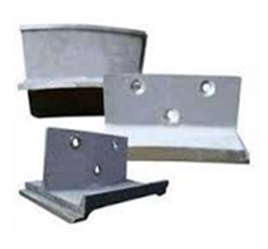
The properties of steel and its yield strength considerably decrease as the steel absorbs heat when exposed to high temperatures. Heat resistance means that the steel is resistant to scaling at temperatures higher than 500 deg C. Heat resistant steels are meant for use at temperatures higher than 500 deg C since they have got good strength at this temperature and are particularly resistant to short and long term exposure to hot gases and combustion products at temperature higher than 500 deg C. As these steels are used over a certain broad temperature ranges, All the heat resistant steels are composed of several alloying elements for the purpose of achieving the desired properties and are used in applications where resistance to increased temperatures is critical. Heat resistant steel must not be exposed to flame and a direct contact with carbon must be avoided to prevent the lowering of heat resistance due to carburization
|
ISI |
Chemical Composition % |
||||||
|
Specifi- |
C |
Si |
Mn |
Ni |
Cr |
S |
P |
|
Gr 1 |
0.4 |
2.0 |
1.0 |
- |
12.14 |
0.05 |
0.05 |
|
Gr 2 |
0.31 |
2.0 |
1.0 |
- |
27.30 |
0.05 |
0.05 |
|
Gr 3 |
1.20 |
2.0 |
1.0 |
- |
27.30 |
0.05 |
0.05 |
|
Gr 4 |
0.20 |
2.0 |
1.0 |
4.0 |
26.0 |
0.05 |
0.0005 |
|
Gr 5 |
0.20 |
2.0 |
2.0 |
8.0 |
18 |
0.05 |
0.0005 |
|
Gr 6 |
0.20 |
2.0 |
2.0 |
8.0 |
26.0 |
0.05 |
0.0005 |
|
Gr 7 |
0.20 |
2.0 |
2.0 |
11.0 |
23.0 |
0.05 |
0.0005 |
|
Gr 8 |
0.15 |
2.5 |
1.5 |
13.0 |
19.0 |
0.05 |
0.0005 |
|
Gr 9 |
0.20 |
2.0 |
2.0 |
18.0 |
23.0 |
0.05 |
0.0005 |
|
Gr 10 |
0.20 |
2.5 |
2.0 |
18.0 |
28.0 |
0.05 |
0.0005 |
|
Gr 11 |
0.20 |
2.0 |
2.0 |
23.0 |
19.0 |
0.05 |
0.0005 |
|
Gr 12 |
0.35 |
2.5 |
2.0 |
33.0 |
13.0 |
0.05 |
0.0005 |
|
Gr 13 |
0.35 |
2.5 |
2.0 |
37.0 |
17.0 |
0.05 |
0.0005 |
|
Gr 14 |
0.35 |
2.5 |
2.0 |
64.0 |
15.0 |
0.05 |
0.0005 |